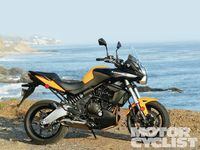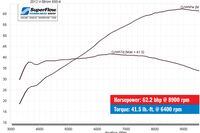Adventure-touring bikes are hot right now. So hot, in fact, that folks have been dropping the “touring” suffix lately and just calling them “adventure bikes.” Seems every Tom, Dick and Harry has started calling himself Helge and is planning to ride around the world. Or at least hoping to look like he is.
The trouble with adventure bikes is they’re often expensive. Never mind the fact that the BMW R1200GS is a perennial best-seller, not everyone has 20-large to drop on a motorcycle. At the high end, Yamaha’s Super Tenere, at $14,500, is the bargain of the bunch. That’s a big check to write, especially if the rider in question has a spouse who’s not wholly invested in the, um, investment.
That’s where these two middleWeights come in. Priced at less than half of what a top-of-the-line adventure bike costs, the Kawasaki Versys ($7899) and Suzuki V-Strom 650 ($8299 with standard ABS) can do everything those bikes can do without killing the rest of your travel budget. Plus they get such exceptional fuel mileage that you could literally ride them for years on the money you saved.
Each is now in its second generation. The Suzuki is both older and newer, having debuted in 2003 and been redesigned for 2012. It benefits (if that’s the word) from the same sort of redesign that the SV650 underwent a few years ago, with softer, rounder edges and a two-tone paint scheme. So yes, you could say it’s been hit with the Gladius stick. Nicknamed the “Wee-Strom” in deference to its 1000cc bigger brother, “Wii-Strom” might now be more fitting as it looks like something out of a video game.
The Versys broke cover in 2008, and was redesigned for 2010. Already celebrated in these pages as our 2008 Motorcycle of the Year, it likewise underwent a makeover with a more aggressive shape, vertically stacked headlights and a two-tone paint scheme. It arguably looks even more like something out of a video game, and in fact wouldn’t look out of place in a Transformers movie. Interestingly, both of our testbikes were mustard-colored, the Versys French’s yellow and the V-Strom Gulden’s spicy brown.
“Spicy” only applies to their paint, however, as both of these bikes are capable if not peppery performers. With around 60 horsepower on tap, these twin-cylinder 650s are just powerful enough to be fun for a solo rider, but add a passenger and/or luggage and they fall flat. Oh, they’ll still haul you uphill, and accelerate you to freeway speeds; it just takes longer—plan your passes accordingly. Even so, it’s enough power for most people, most of the time.
Of the two, the Kawasaki’s engine is more captivating. More oversquare, with a bigger bore and shorter stroke than the Suzuki’s, it has a revvy, frolicky feel, all without sacrificing midrange pull. Parallel-twins aren’t renowned for their smoothness, however, and true to form the Versys is annoyingly buzzy at freeway speeds. The V-Strom’s 90-degree V-twin should theoretically run smoother, and while it is less buzzy than the Versys, it still vibrates more than we’d like.
With a tad more torque on tap, the Kawasaki has superior roll-on power, but its on/off throttle response can be jerky. Light flywheels combined with high compression make for pronounced engine braking; a little clutch slippage helps. Tell your sportbike buddies your bike has a “carbon-based slipper clutch.” That’ll throw them.
The Suzuki feels slower under hard acceleration, but actually makes more peak power than the Kawasaki, and is quicker in the quarter-mile. Part of this may be due to the V-Strom’s V-twin engine, which is deceptively happy to lope along. It’s also geared quite low, as you find yourself riding a gear or two taller than normal. Again, as with the Versys, there is pronounced engine braking; a little clutch slippage helps. The V-Strom wins on fuel economy, routinely getting 50 miles per gallon or more. Combine that with its 5.3-gallon gas tank and you can go 250 miles on a tankful. If you commute to work, you’ll fill up once a week. The Versys’ 5.0 gallons against mid-40s average mpg add up to somewhat less.
Both of these engines are fuel-injected, naturally, and the Suzuki earns higher marks for its smoother response. Both have cable-actuated clutches, as well—bonus points to the Kawi for having an adjustable lever—and both have a heavier pull than we’d like to see on bikes that will likely be ridden by women. Gear-change action is merely acceptable on both, our V-Strom sometimes popping out of gear on the first-to-second shift. If you ride with off-road boots, it pays to raise the shift lever one spline.
In terms of riding position, the Kawasaki’s is more “sportsmanlike,” whereas the Suzuki’s is roomier and more comfortable. That holds doubly true for the passenger, as the Kawi’s two-piece seat is stepped, so the passenger sits much higher than the rider, as on a sportbike. The Kawi has a great seating position: up on top of the bike with a commanding view, not down in it like the Suzuki. The Kawi’s rider’s seat is thin but dense; unfortunately, it also angles downward, putting precious parts of the rider’s anatomy in close contact with the gas tank. The Kawi’s bars are wide, yet narrower than the Suzuki’s, and while its windscreen is adjustable, none of its three positions afford as much wind protection as the Suzuki’s much larger windshield.
Both of these bikes have nicely appointed dashboards, but the Suzuki wins the geek award, boasting a digital gear indicator and an outside air temperature readout, so you know just exactly how hot or cold you are. It also has two tripmeters, each with its own on-the-fly mpg rating, plus adjustable dash brightness. You toggle through the various functions with what would normally be the passing-light switch; that’s now integrated into the high/low-beam switch. The Versys has a clock. Phew!
Head down a twisty backroad, and the Versys rules. It’s got an inverted fork, a sexy, side-mounted shock and a long, stiff, asymmetric swingarm. Combine that with its wide handlebar, upright seating position and sporty (read: stiff) suspension settings, and you can slam it into corners like a supermoto bike. The rear suspension has no linkage, but it does have two-stage damping, changing from plush to stiff mid-stroke. (Think KTM PDS.) As a result, the Versys is bothered by mid-corner bumps, dips and rises, and doesn’t care for rough or uneven pavement. Suspension adjustments include rebound damping (on the right fork leg only), plus preload and a cheesy rebound-damping dial on the shock.
The V-Strom feels very “put-together” and “sweet,” with nice, neutral handling. It has a dirtbike feel on pavement but feels like a streetbike in the dirt. Its fork is a traditional right-side-up design, with an old-school slotted preload adjuster but no provisions to vary damping. Out back is a single shock with a linkage. Bonus points for the remote hydraulic preload adjuster that lets you tailor the ride to suit your load with the simple turn of a knob. There’s also a rebound damping adjuster, but no way to change compression.
While both of these bikes use the same brake calipers, different rotors, wheels, tires and suspension mean they perform differently. The Versys stops on a dime with its stiff suspension and sportbike-sized, 17-inch front tire. The V-Strom scores high marks for having ABS as standard (a plus), but no provision to shut it off (a minus). Stopping power is merely acceptable, however, due to its skinnier 19-inch front tire. (The payback is a wider range of semi-dirt tires for the front.) It’s also fairly easy to get into the ABS, which is anything but transparent, the brake lever and pedal pulsing noticeably.
In the end, these two middleweights are perhaps more different than they are similar. The Kawasaki Versys is a poor man’s Ducati Multistrada—an all-day comfortable sportbike in adventurer’s clothing. The Suzuki V-Strom is a working stiff’s BMW GS—a proper adventure-tourer that’s just a set of saddlebags away from circumnavigating the globe. Both are amply supported by the farklemarket for luggage and add-on lights and all the adventure-toury stuff, the Suzuki arguably more so. Which one of these is right for you depends entirely on what you want from a motorcycle.
Brian Catterson
Age: 50 | Height: 6'1" Weight: 215 lbs. | Inseam: 34 in.
Much as I love dirtbikes, I still prefer streetbikes on the street. And as far as I’m concerned, that made for an immediate winner here. The Versys may literally be long-legged, but it’s still very much a sportbike, with a fun, revvy motor and agile handling. The gas mileage isn't quite as good as the V-Strom, but it does pretty well, and costs less. I like the way it looks, too, at least in Metallic Spark Black. It’s pretty menacing for a middleWeight!
The V-Strom is longer and lower, and while its 19-inch front wheel makes it marginally better off-road, its tires are still largely street-biased, so it’s pretty much limited to graded dirt roads. If it had a broader range, like its Adventure counterpart does—or should—I’d be all-in. But until then, I’m going green—even if it’s yellow.
Karel Kramer
Age: 57 | Height: 6'1" Weight: 225 lbs. | Inseam: 32 in.
I know some riders find these middleWeights boring, confused or drab, but not me. I began street riding on small-displacement dual-sport bikes and progressed to standards with a sit-up riding position. Factor in decades of hardcore off-roading, and you can see why I like the V-Strom and the Versys. Of these two, however, I would own the Suzuki. The riding position works for me, and the linkage suspension and larger front wheel make it more composed than the Kawasaki on bumpy roads. I’ll admit that the Kawi has the Suzi smoked in roll-on power, but it’s buzzy at freeway speeds. The ’Strom’s EFI is more civilized transitioning from off-throttle, and it feels relaxed at speeds that endanger my driver’s license. I like the look of the Kawasaki, but the Suzuki makes me want to go riding. And at 50-plus mpg, I can afford to go!
Words: Marc Cook
As the motorcycle industry digs out from stem-to-stern economic upheaval, would you believe that the category leading the return to sales success is none other than dual-sport? According to Motorcycle Industry Council figures, dual-sport bikes led the market by posting sales figures up 12.7% in the first quarter of 2012 compared with the same time the year before.
Why the dual-sport resurgence, if you want to call it that? Partly cost: The popular Japanese DSes are all, ah, mature designs, so the MSRPs won’t cause a heart attack. A Suzuki DR650SE is still under $6000, some $2300 below a V-Strom 650. You could almost buy two Ds for the Price of one GSX-R600. (Yes, we know, different horses, different tracks.) The dual-sport surge is also fueled by the popularity of adventure bikes; BMW's R1200GS is still among its best sellers, and Yamaha has done very well with the Super Tenere. Maybe, too, buyers in today’s market value one bike that can do two things relatively well over models that do one thing extremely well. Call it the new practicality.
























/cloudfront-us-east-1.images.arcpublishing.com/octane/FZXHNOQRNVA3BIDWAF46TSX6I4.jpg)
/cloudfront-us-east-1.images.arcpublishing.com/octane/JRSFLB2645FVNOQAZCKC5LNJY4.jpg)
/cloudfront-us-east-1.images.arcpublishing.com/octane/ITNLTIU5QZARHO733XP4EBTNVE.jpg)
/cloudfront-us-east-1.images.arcpublishing.com/octane/VZZXJQ6U3FESFPZCBVXKFSUG4A.jpg)
/cloudfront-us-east-1.images.arcpublishing.com/octane/QCZEPHQAMRHZPLHTDJBIJVWL3M.jpg)
/cloudfront-us-east-1.images.arcpublishing.com/octane/HXOUJXQWA5HBHGRO3EMJIGFMVI.jpg)

/cloudfront-us-east-1.images.arcpublishing.com/octane/3TIWWRV4JBBOLDVGRYECVVTA7Y.jpg)
/cloudfront-us-east-1.images.arcpublishing.com/octane/KIX5O23D5NAIBGFXBN3327DKZU.jpg)
/cloudfront-us-east-1.images.arcpublishing.com/octane/7GJYDUIPXRGMTMQKN6ONYOLBOU.jpg)
/cloudfront-us-east-1.images.arcpublishing.com/octane/MUQLOVLL2ZDGFH25ILABNBXKTI.jpg)
/cloudfront-us-east-1.images.arcpublishing.com/octane/TNOU5DNE2BC57MFPMGN2EIDXAM.jpg)
/cloudfront-us-east-1.images.arcpublishing.com/octane/GTCXACQGJ5HAPDTGWUQKDEH44E.jpg)
/cloudfront-us-east-1.images.arcpublishing.com/octane/S35YGSEMEZB4BLTDJTSZPF4GLA.jpg)
/cloudfront-us-east-1.images.arcpublishing.com/octane/5UOT6HPX2JFMRJAX6EH45AR4MQ.jpg)
/cloudfront-us-east-1.images.arcpublishing.com/octane/OKWOJWAKP5EP3OACCRRWPCIX2Q.jpg)
/cloudfront-us-east-1.images.arcpublishing.com/octane/2WF3SCE3NFBQXLDNJM7KMXA45E.jpg)
/cloudfront-us-east-1.images.arcpublishing.com/octane/G4MG6OUCJNBSHIS2MVVOTPX65E.jpg)
/cloudfront-us-east-1.images.arcpublishing.com/octane/IIGGWFOTOJGB7DB6DGBXCCMTDY.jpg)
/cloudfront-us-east-1.images.arcpublishing.com/octane/QSTCM6AVEZA5JJBUXNIQ3DSOF4.jpg)
/cloudfront-us-east-1.images.arcpublishing.com/octane/U4I7G625B5DMLF2DVIJDFZVV6M.jpg)
/cloudfront-us-east-1.images.arcpublishing.com/octane/B6XD6LS6IVCQPIU6HXDJSM3FHY.jpg)
/cloudfront-us-east-1.images.arcpublishing.com/octane/ICL63FEDDRDTTMINYICCEYGMDA.jpg)
/cloudfront-us-east-1.images.arcpublishing.com/octane/FCGZHQXRBZFLBAPC5SDIQLVF4I.jpg)